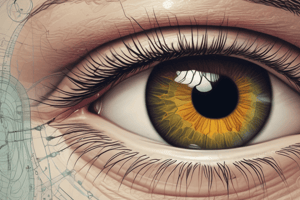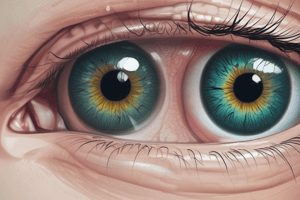Podcast
Questions and Answers
What percentage of Horner's syndrome cases associated with internal carotid artery dissection are accompanied by ipsilateral orbital, face, or neck pain?
What percentage of Horner's syndrome cases associated with internal carotid artery dissection are accompanied by ipsilateral orbital, face, or neck pain?
- 58% (correct)
- 70%
- 25%
- 30%
What is the primary purpose of taking a thorough history in patients with pupil abnormalities?
What is the primary purpose of taking a thorough history in patients with pupil abnormalities?
- To determine the severity of the disorder
- To prescribe medication for the patient
- To diagnose Horner's syndrome
- To identify potential causes of pupil anomalies (correct)
Why is pharmacological testing of limited value in pupil anomalies?
Why is pharmacological testing of limited value in pupil anomalies?
- It has poor availability of reagents and high false positive and false negative rates (correct)
- It is not approved by regulatory bodies
- It is time-consuming
- It is expensive
What level of evidence is associated with the recommendation to perform an initial slit lamp assessment?
What level of evidence is associated with the recommendation to perform an initial slit lamp assessment?
What is the recommended course of action if Horner's syndrome is associated with neck pain?
What is the recommended course of action if Horner's syndrome is associated with neck pain?
What is the primary role of practitioners in managing pupil abnormalities?
What is the primary role of practitioners in managing pupil abnormalities?
What is the purpose of the pupils constricting when looking at near objects?
What is the purpose of the pupils constricting when looking at near objects?
What is the term for the condition where the pupils are usually slightly different in size?
What is the term for the condition where the pupils are usually slightly different in size?
What is the condition characterized by a small pupil on one side, a drooping of the upper lid, and no sweating on the same side of the face?
What is the condition characterized by a small pupil on one side, a drooping of the upper lid, and no sweating on the same side of the face?
What is the condition where both pupils are small and there is no reaction to light, but constriction for looking at near objects still happens?
What is the condition where both pupils are small and there is no reaction to light, but constriction for looking at near objects still happens?
What is the normal difference in the amount of light entering the eye as a result of the pupils constricting and dilating?
What is the normal difference in the amount of light entering the eye as a result of the pupils constricting and dilating?
What happens to the pupils in bright light?
What happens to the pupils in bright light?
Flashcards are hidden until you start studying




